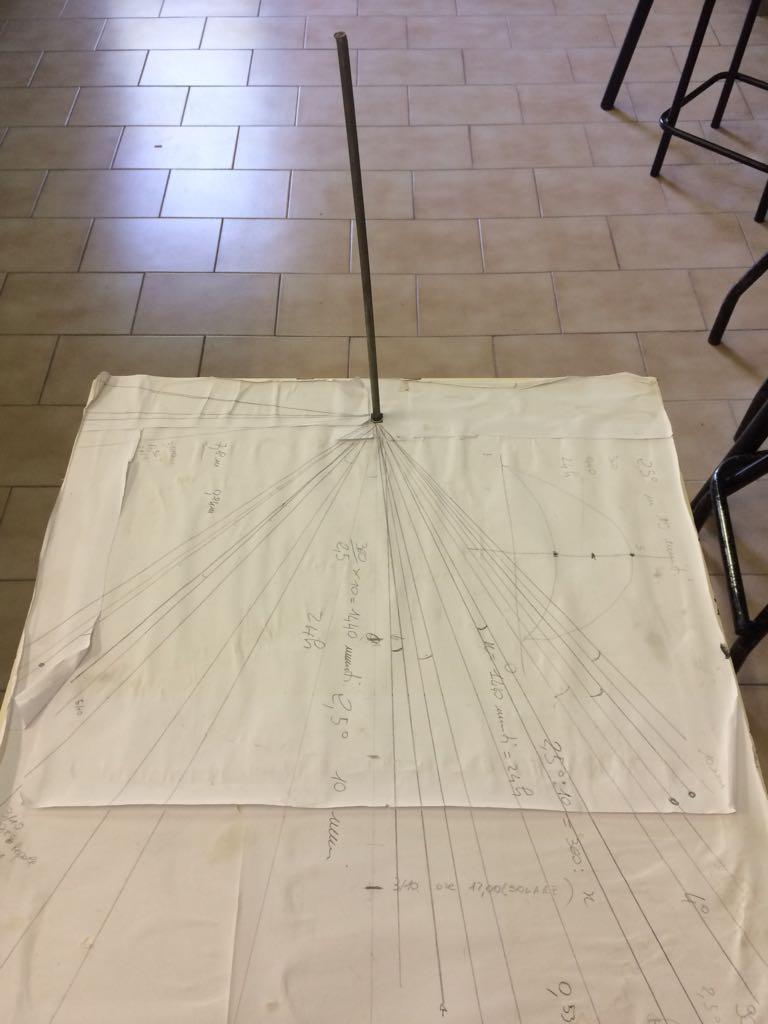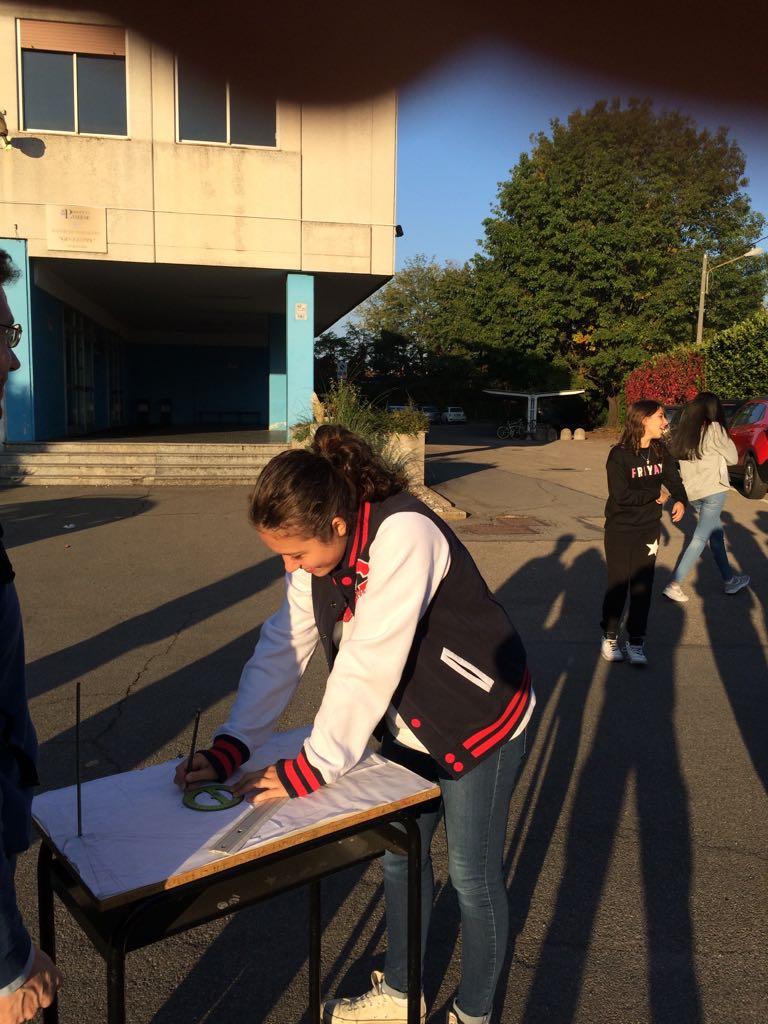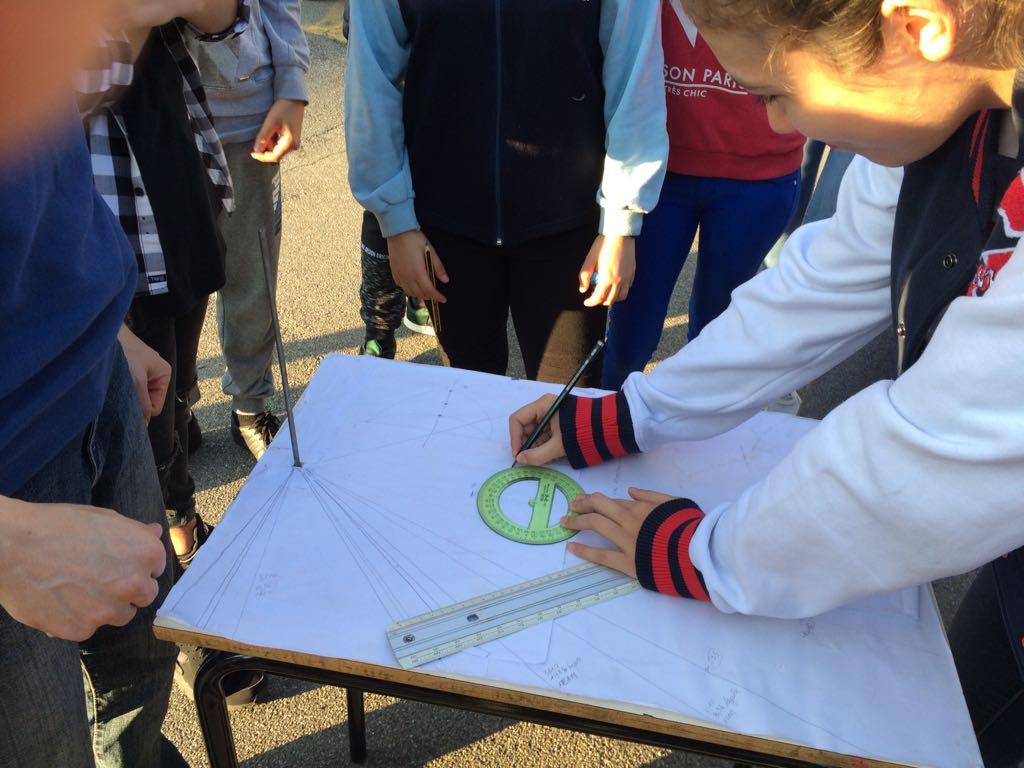December 2017

November 2017

October 2017

CEIP Jose María de la Fuente - Spain
We published some, but there were more articles for our TMS November edition, check them all in this padlet.
ITCS " G. Zappa " - Saronno , 1 ACT
TIME MEASUREMENT OF THE ROTATION OF THE EARTH AROUND ITS AXIS
Last Friday we made a Physics experiment in the school yard.
We wanted to measure the time of rotation of the earth around its axis.
For the experiment you need:
Instructions
-
orient the gnomon in the direction south-north, moving the bar towards the sun
-
consider the shadow produced by the gnomon
-
draw a line on the shadow of the gnomon and start the stopwatch
-
after 10 minutes draw a new line on the shadow that has moved
-
using the protractor measure the angle between the two lines
The result of our measurement was 2.5 degrees.
To calculate the time of rotation of the earth around its axis we use the following proportion:
10’ : 2.5° = x : 360°
10 x 360
_____________________ = 1440’ = 24h
X =
2.5
Therefore we demonstrated that the earth takes 24 hours to make a complete rotation around its axis.



Liquid gold
For the first time and with the stamp of the Americans, a clinical study demonstrates that consumption of extra virgin olive oil protects the body from thrombosis

Three spoonfuls of oil a day benefit a lot our health.The famous proverb may not mention the oil, but a new study shows that olive oil has beneficial properties for the body. According to the study, the same action as 400 mg of irebuthene, the known drug, causes the human body to consume three spoonfuls of extra virgin olive oil due to its oil content.
Regular and diffuse light reflection
Rute Duarte - Escola B. 2,3 Pedro Eanes Lobato (Portugal)
|
The propagation of light in a straight line can be disturbed by obstacles that cause the light rays to change direction. It is very common to see reflexes every day. I give as an example the reflection of an image in the water, or when we see our image in a mirror. These images result from the fact that light has the ability to reflect on certain surfaces.
|
 |
Reflection of light occurs when light strikes a surface and is returned by that surface.
|
|
Regular reflection happens when the light is reflected on a smooth, polished surface (in a mirror for example), and it reflects in only one direction.
|
 |
|
|
Light diffusion, or irregular reflection, happens when the light is reflected in different directions, when the reflection surface is rough. I give as an example an image reflected in water, in which the water surface is not completely smooth.
|
 |
|
Echolocation in animals
Laura Mendes - Escola B. 2,3 Pedro Eanes Lobato (Portugal)
|
Echolocation is a sense and sophisticated biological ability to detect the position or distance of an object. In animals, the interpretation of echolocation is important because it helps them to find prey or to move around the environment.
|

We experimented with wave reflection in our ripple tank apparatus. (click the photo to check the video).
|
|
Bats - They emit a high frequency sound to locate their prey and move around the environment. (listen to a recording of Pipistrellus bat approaching its prey by clicking here).
|
 |
|
Dolphins - The dolphin has a good acoustic echolocation system that allows it to get information about other animals and the environment.
|

|
Can you pierce a wooden skewer stick through a balloon without popping it?
Junior High School of Xanthi-Greece
You will need the following materials:
1. balloons
2. wooden skewers
Blow up a balloon – not too full – and tie the opening shut. Try to stick the skewer into the side of the balloon. The balloon pops. Insert the skewer with a gentle twisting motion into the end of the balloon opposite the knot. Continue pushing and twisting the skewer until the tip emerges from the other end, near the knot.
Why doesn't the balloon pop?

The rubber in the balloon consists of many long molecules that are linked together. It's similar to the way all of the noodles in a plate of spaghetti stick together. These long molecules are called polymers; when molecules of a polymer are chemically attached to each other, it is called cross-linking.

These links hold the polymer molecules together and allow them to stretch…up to a point. When the force or tension pulling on the cross-links is too great, they will break, and the polymer will pull apart.
The rubber at the ends of the balloon is stretched out less than in the middle of the balloon. Therefore, there is less force pulling on it. This allows the tip of the skewer to break some polymer cross-links, push aside the molecules of rubber, and slide into the balloon.
I can become a gas without melting !!
(Junior High School of Xanthi-Greece; 2th grade class Β6)
There are substances that pass directly from the solid to the gas phase.Such a substance is iodine which is solid in ambient conditions. Heating it, causes a transition directly from the solid to the gaseous phase. This transition is called sublimation.


Clinostat - Junior high school of Thermi
Mixture Properties
(Junior High School of Xanthi - Greece
Tarchanidou Michaela,Tektonopoulos Thanassis, Chilmi Oglou Gioulsen)
Initialy, we prepare a water-alcohol mixture by combining 25 mL of alcohol with 25 mL of water. Then, we dip the paper into the mixture of water and rubbing alcohol, using a poker and make sure the paper gets completely soaked. After that, we remove the paper and gently shake off any excess liquid.
Then, the paper is lit with a lighter.

The paper looks like it’s burning, but it isn’t.

Finally, the burning is stopped using water. We then discover that the paper has remained in its original condition.

The secret, of course, is the addition of water to the mixture. The two ingredients of the mixture sustain their properties.
Electric Field /Sparks
(Junior High School of Xanthi - Greece
Bakirtzi Georgia,Papoutsi Vassilia,Rizou Anastasia)
As the disks of Wimshurst turn, the charged strip induces an opposite charge on the corresponding strip on the other disk. The metal brushes carry the charges to the opposite strips, and a pair of pointed metal combs collect the charges off each disk. The charge gradually gets larger as the disks keep rotating. Eventually a spark jumps across the gap between two brass spheres connected to the collecting combs.

We also use the machine to visualize the electric field between two charges of the same polarity and two charges of opposite polarity.

DNA Christmas tree
(C5 Class - A. Tachtazti, A. Rizou, D. Stergiou, G. Bakirtzi, V. Papoutsi, N. Symeonidou – Elina Petridou Junior High School of Xanthi-Greece )

The construction is comprised of:
(a) Two pieces of iron wire, 65cm long
(b) Plasticine
(c) Pieces of colored plastic straws, 2,5cm long
(d) A wooden skewer

The iron wire is perpendicularly folded back and forth in 4cm intervals (representing the phosphate group and the deoxyribose monosaccharide),
so that 4 cm long branches are created.
The 4 cm branches are then bent so that a hook is created. One of the pieces of wire is shaped so that the hook bend is horizontal and for the
other piece of wire, the hook bend is vertical.
This way, the hooks can securely fit into each other and lock.
After the pieces of wire are locked together, they are bent so as to create a helical shape and then the plastic straw pieces are applied on the
branches. The color of the straw pieces represents the nitrogenous bases.
Yellow represents cytosine, orange represents guanine, pink represents adenine, blue represents thymine and they have been placed so as
cytosine is matched to guanine and adenine is matched to thymine.
The structure is supported using plasticine as the footing and a wooden skewer as a pillar.

light a Play Doh Christmas tree
(Teachers: C5 Class students - A. Tachtazti, A. Rizou, A. Konstandaros, D. Stergiou, G. Bakirtzi, V. Papoutsi, N. Symeonidou - Junior High School
of Xanthi-Greece )
Electricity and circuits were part of our class curriculum earlier this year. Therefor it was a nice idea to test our knowledge,
by teaching younger students this subject.

We brainstormed for ideas to find ways to make it simple enough for them. We also decided to make an analogy f
or electron movement inside the wire, using an extra large straw for the wire and small pieces of straw for the electrons.

After a brief theory introduction, each one of us mentored a team in the school lab.

All teams had to make a circuit using a battery, a led and Play Doh for wire, add more leds and see what happens.
Overall it was fun but also very inspiring to be the teacher!

( Students: A3 Class - Junior High School of Xanthi-Greece )
For the last lesson before the Christmas break, senior students and our teachers had two surprises for us. Firstly, teachers were only watching and all the teaching was performed by students!!

We learned about electric current and how conductive materials allow it to flow freely, while insulating materials
make it slow down or stop.
Secondly, the most unique activity was to create circuits with Play Doh and light a led.

Who knew Play Doh is a conductive material!!!

It was fun to have mentors in our teams, allowing us to be creative.
 In the end all teams managed to create a Christmas Tree and light it!!
In the end all teams managed to create a Christmas Tree and light it!!
Merry Christmas to all!!
Traffic lights on a Breadboard !!
(Junior High School of Xanthi-Greece; 3th grade class,Fedra Samakovidou,Rafayl Sialakis,Georgia Pavlidou,
Papadoudis Dimitris, Papadoudis Simeon )

A circuit implemented on a breadboard resembles the principle of operation of traffic lights.
Changing the connection of a single wire we can light a different LED lamp.
Additionally using two resistors connected in parallel, we can operate the LEDs
on a greater current which makes them brighter and using the same resistors in series, we can operate
the LEDs on a smaller current which makes them dimmer.

The balloon that inflates in and out of a bottle
( B6 Class - Junior High School of Xanthi-Greece )
Materials: Bottle, Small balloon, Water, Heat
Experimental Procedure

Fill the bottle with a little water, heat it, and wait a little.
Then stretch the balloon around the mouth of the bottle and wait.
Watch the balloon inflate! Then withdraw the bottle from the heat. Now the balloon takes its initial form b ut a little later it is suddenly inflating again, though this time it inflates towards the inside of the bottle.
ut a little later it is suddenly inflating again, though this time it inflates towards the inside of the bottle.
What’s happening here is that as the water is getting hotter, the water evaporates and hot steam forms in the bottle, that rises upwards, taking the air out of the bottle. When the balloon is inserted, the opening is sealed,
confining the air molecules and steam between the inside of the bottle and the outside of the balloon. The hot air and the steam in the balloon increase the pressure inside, expanding (pushing outwards) the balloon and the balloon has enough elasticity to allow it to do just that!
When the steam cools it condensates, partially turning into liquid, so now the pressure inside the bottle is less than that outside and the balloon is being pushed in and inflates again inside the bottle.
The Magdeburg hemispheres
( B6 Class - Junior High School of Xanthi-Greece
The Magdeburg hemispheres were designed to demonstrate the vacuum pump that Guericke had invented. One of them had a tube connection to attach the pump with a valve to close it off. When the air w as sucked out from inside the hemispheres, and the valve was closed, the hose from the pump could be detached, and they were held firmly together by the air pressure of the surrounding atmosphere.
as sucked out from inside the hemispheres, and the valve was closed, the hose from the pump could be detached, and they were held firmly together by the air pressure of the surrounding atmosphere.
Guericke's demonstration was performed on 8 May 1654. Thirty horses, in two teams of fifteen, could not separate the hemispheres until the valve was opened to equalize the air pressure.
We perform a Reenactments of von Guericke's experiment with suction cups for windows.